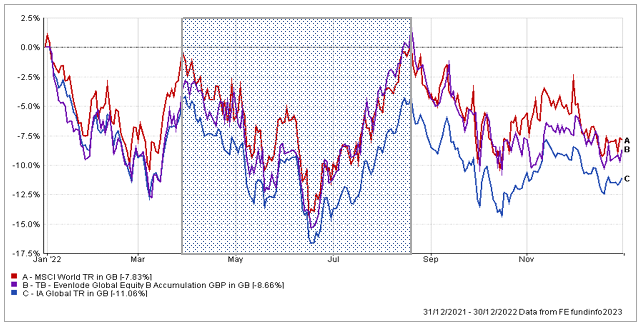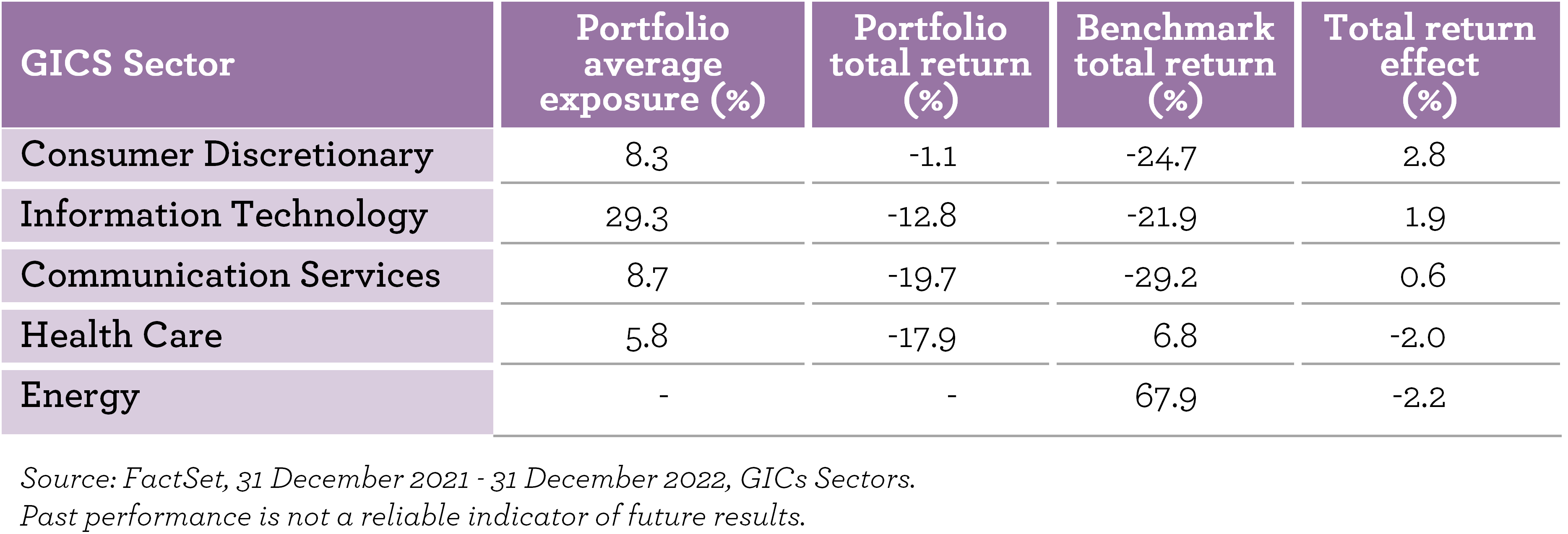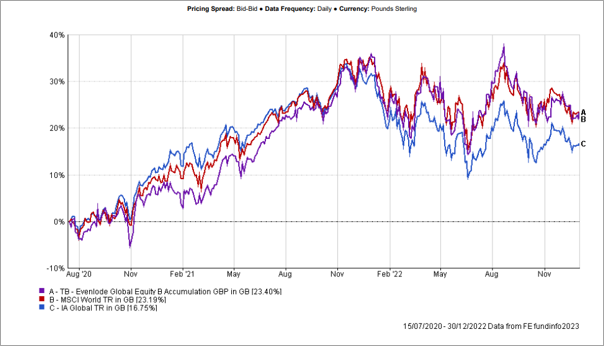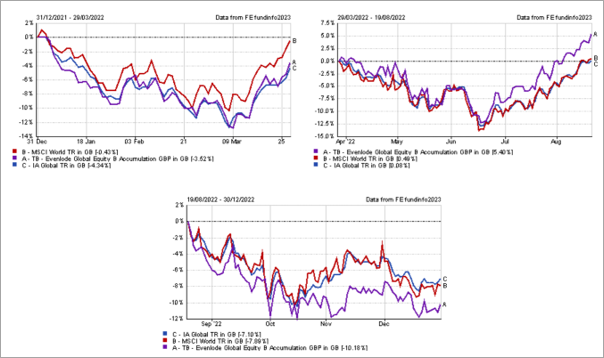The commentary below applies to Evenlode Global Equity strategy. Performance figures are quoted for the TB Evenlode Global Equity portfolio.
The recent FIFA World Cup final was a thriller, labelled a contender for the most exciting final of all time. Argentina and France vied for supremacy, with leads earned and eroded before a penalty shootout eventually separated the teams and cemented Lionel Messi’s legacy as an all-time great. The unpredictability and uncertainty of the match mirrored that of 2022 as a whole. After an upbeat 2021 in equity markets, few could have foreseen what was to follow in 2022. The invasion of Ukraine, rampant inflation, and rates controversy drove headlines and increased market volatility. In this investment view we look back at Evenlode Global Equity’s highlights and consider what lessons we can learn from the past year.

2022 Performance
Over the past year, Evenlode Global Equity outperformed the IA Global sector (the fund peer group) while slightly trailing its comparator benchmark, the MSCI World Index. The latter performance differential is approximately equal to the annual fees charged on the fund, meaning that the gross performance (i.e. before costs) was in line with the benchmark. This surprised us as the fund is actively managed, does not track benchmark risk factors, and has an active share of 88%[i]. The Evenlode Global Equity fund also does not invest in asset intensive sectors, including banking, insurance, mining and energy production. All of these factors should in principle have meant a significantly different performance profile.

Dividing the year
The first half of the year was more volatile on an absolute return basis, with the February invasion of Ukraine inflating energy prices and creating expectations of higher peak rates. The fund’s lack of exposure to energy and higher exposure to quality created a significant drag on performance until late March. The majority of the portfolio reported full year 2021 results in February and March, and we were generally pleased with their robust fundamentals. For those which reported, average organic revenues grew 9% and earnings grew 19% (excluding those where Covid created very dramatic year-on-year comparisons). Company management teams communicated a tone of cautious optimism, with guidance in many cases heavily caveated.
Following the market peak in late March, concerns rose over heightening inflation and potential central bank responses. These concerns proved warranted as between May and August, the Federal Funds Rate increased from 0.5% to 2.5%, resulting in a rapid fall in bond prices. As interest rates rose, the discount rates applied to companies’ future earnings streams also increased. This naturally depressed the share prices of growth companies that derive the majority of their value from future earnings, relative to companies with strong current cash generation.
Despite market weakness, this period provided the fund’s greatest outperformance for the year relative to the benchmark. We think this fact comes from our portfolio being entirely weighted towards companies with excellent current economics and highly resilient businesses. As expectations of higher rates and tougher operational conditions set in, this naturally hit businesses hard which were too much skewed to the ‘jam tomorrow’ camp, particularly software companies which are currently unprofitable where all of the cashflow value is sitting in remote years. It also hit companies with less secure business models and greater doubts over their ability to weather harsh economic times.
This was most strikingly reflected by the Evenlode Global Equity’s relative performance during the late March to mid-August period (highlighted in the previous chart) within two of GICS sectors that had the greatest exposure to the discounting dynamic described above. The fund’s Information Technology (IT) constituents averaged a 6.1% return, while the benchmark’s IT exposure returned
-1.8%, and the fund’s Consumer Durables exposure averaged 10.4%, outperforming the benchmark’s sector exposure by 13.2%.
After the mid-August peak, the market once more fell away as forward economic indicators worsened. Notably the US bond yield curve inverted in October, with the rate of the 3-month US treasury bill rising above the rate of the 10-year bond . This indicator has proved a (somewhat) reliable indicator of weakening economic demand over the following 6 to 18 months. This led to traditionally defensive sectors like healthcare, energy, and banking outperforming in late 2022.
Evenlode Global Equity is underweight in these sectors, and has zero weight to sectors with higher leverage and frequently lower and/or more volatile returns on invested capital. As a result, the fund lagged the index in the final few months of the year.

Sector Analysis
Further insight of performance can be gleaned from a sector-by-sector analysis relative to the MSCI World Index for the year. Below we consider the material sectors, materiality being defined by a more than 0.5% effect (positive or negative) on relative performance.

By sector, the largest negative contributor to relative performance was from Energy. As mentioned previously, Evenlode Global Equity has no exposure to energy companies, which are typically asset intensive and do not fit our requirements for high returns on invested capital. In 2022, this proved to be a significant disadvantage, as oil and gas prices rose in response to the war in Ukraine and the benchmark energy GICS sector rose 68%. While low exposure to commodity sectors will generate these cyclical headwinds occasionally, we believe that these will be offset by the benefits of investing in businesses with higher and more stable return on invested capital over the long term; we would always prefer to own sectors characterised by predictable and stable earnings as opposed to ones with volatile and unpredictable earnings.
The next largest negative contributor was Health Care, a defensive sector that performed particularly well over the middle period of the year as quality rallied. Our underperformance here came from both relatively low exposure (compared to the benchmark) and poor stock selection. Our only position in the sector was Medtronic, which has disappointed with delays to product developments and poor execution within the diabetes franchise. While Medtronic has had challenges, we believe its core competitive advantages are unimpaired and expect it to do well based on a recovery in elective surgical procedures and improved execution.
On the positive side of the ledger, the fund’s exposure in both Information Technology and Communication Services outperformed the respective MSCI World GICS sectors. While both sectors were among the weakest contributors in absolute terms, our stock selection in these sectors provided excellent mitigation in comparison to the benchmark. Within Communication Services, our computer game developers, Electronic Arts and Nintendo, contributed positively, while our Alphabet position was in line with the sector. Within Information Technology, we had notable positive performance from the payment networks, Mastercard and Visa. In both sectors, we avoid businesses that are currently unprofitable. This proved excellent risk mitigation, as we avoided some of the higher profile valuation corrections that occurred in the first few months of the year.
Finally, we outperformed by the widest margin in Consumer Discretionary, a sector that was notably weak for the benchmark. Within the sector, our star performers were the luxury goods manufacturers LVMH and Hermès, which both posted positive absolute returns for the year. Both companies have high gross margins and excellent pricing power, enabling them to pass on cost inflation to their clients, and prospered as Western markets reopened and affluent consumers demonstrated their indifference to the rates environment. Both businesses also benefitted from the reopening of China in late 2022, as the easing of pandemic sanctions is expected to lead to the return of the Chinese luxury consumer to western markets.
Conclusion
Overall, we are relatively pleased with the resilience of the fund throughout 2022. We experienced significant headwinds from uncertain and inflationary market conditions, an energy-led surge in cyclicals, and a weakening global economic outlook. However, these were offset by careful stock selection and the fund continues to invest in profitable companies with low leverage and high returns on invested capital in the investment world.
Unlike football, we do not go to penalties and we just start the game all over again in the new year. For 2023, Evenlode as ever has the same game plan: to focus on the long-term prospects for all the businesses we invest in, with the expectation that their competitive advantages will drive performance over the next year and beyond, and across a wide range of economic conditions.
As ever, we would like to thank all our investors for their trust and backing, and we continue to focus our efforts on preserving and growing your capital.
Chris, James, Cristina and the Evenlode Global Equity Team
8 January 2023
Appendix 1: Performance since launch

Appendix 2: Performance for intra-year periods 2022

Please note, these views represent the opinions of the Evenlode Team as of 8 January 2023 and do not constitute investment advice.
Where opinions are expressed they are based on current market conditions, they may differ from those of other investment professionals and are subject to change without notice. This document is not intended as a recommendation to invest in any particular asset class, security or strategy. The information provided is for illustrative purposes only and should not be relied upon as a recommendation to buy or sell securities.
For full information on fund risks and costs and charges, please refer to the Key Investor Information Documents, Annual & Interim Reports and the Prospectus, which are available on the Evenlode Investment Management website (https://evenlodeinvestment.com). Recent performance information is also shown on factsheets, also available on the website.
Past performance is not a guide to future returns. The value of investments and any income will fluctuate (this may partly be the result of exchange rate fluctuations) and investors may not get back the full amount invested. Fund performance figures are shown inclusive of reinvested income and net of the ongoing charges and portfolio transaction costs unless otherwise stated. The figures do not reflect any entry charge paid by individual investors.
Current forecasts provided for transparency purposes, are subject to change and are not guaranteed.
Source: Evenlode Investment Management Limited. Evenlode Investment Management Limited is authorised and regulated by the Financial Conduct Authority, No. 767844.
[i]FactSet, 31 December 2021 – active share against MSCI World Index.
[ii]Evenlode, Collated from company reports, 31 December 2021 – 31 March 2022.
[iii]FactSet, 29 March 2022 – 19 August 2022, MSCI World Index and Evenlode Global Equity, GICS Sectors.
[iv]St Louis Fed, https://fred.stlouisfed.org/series/T10Y3